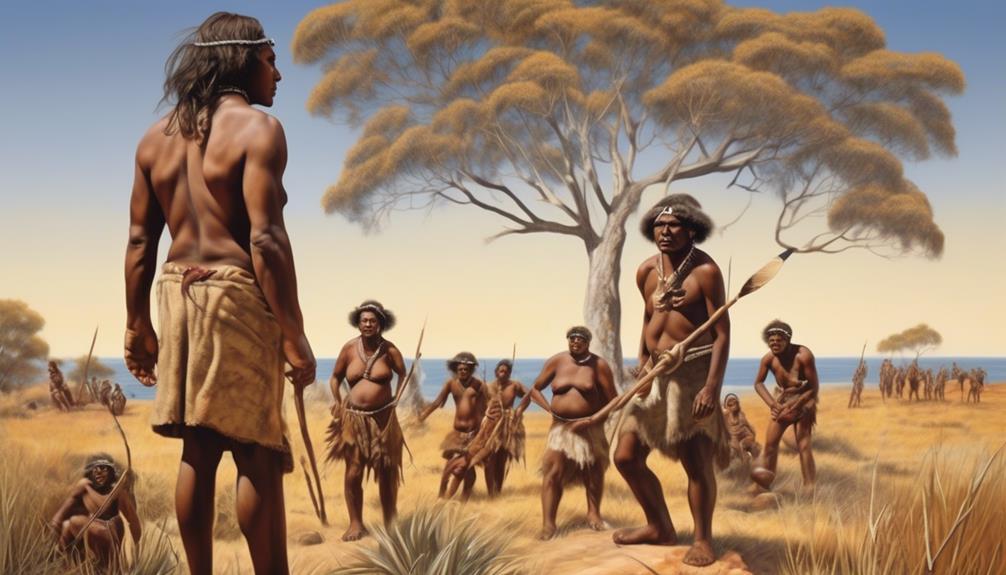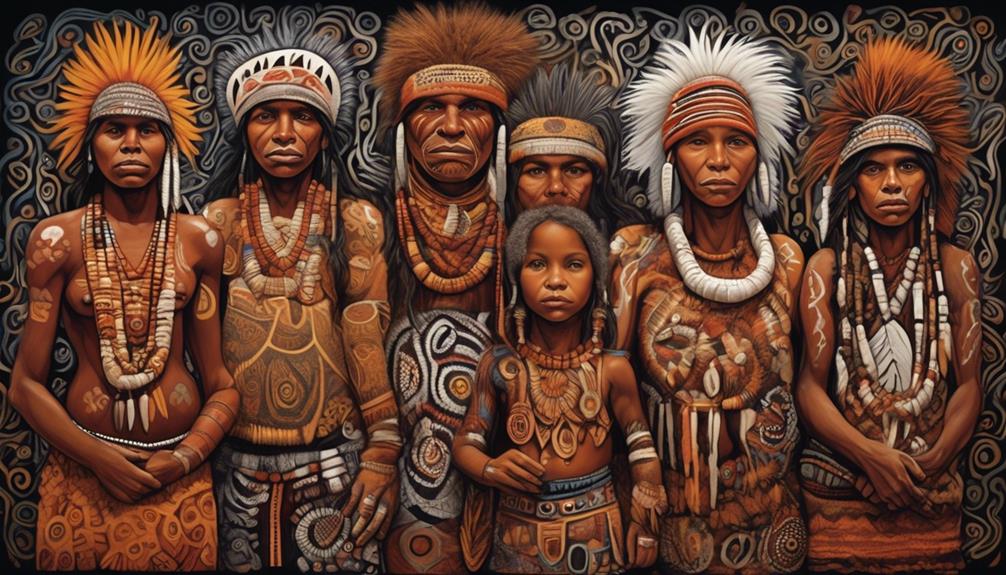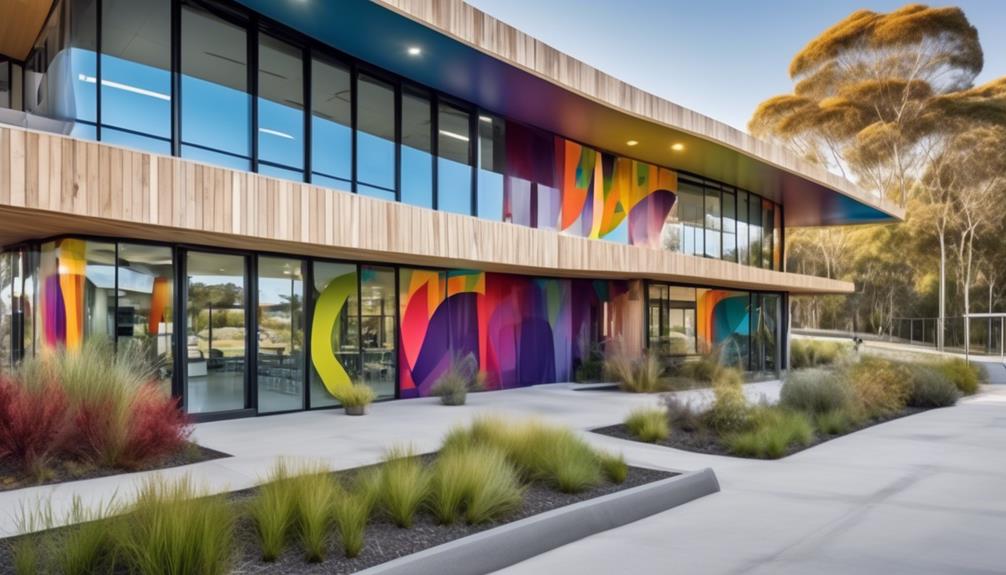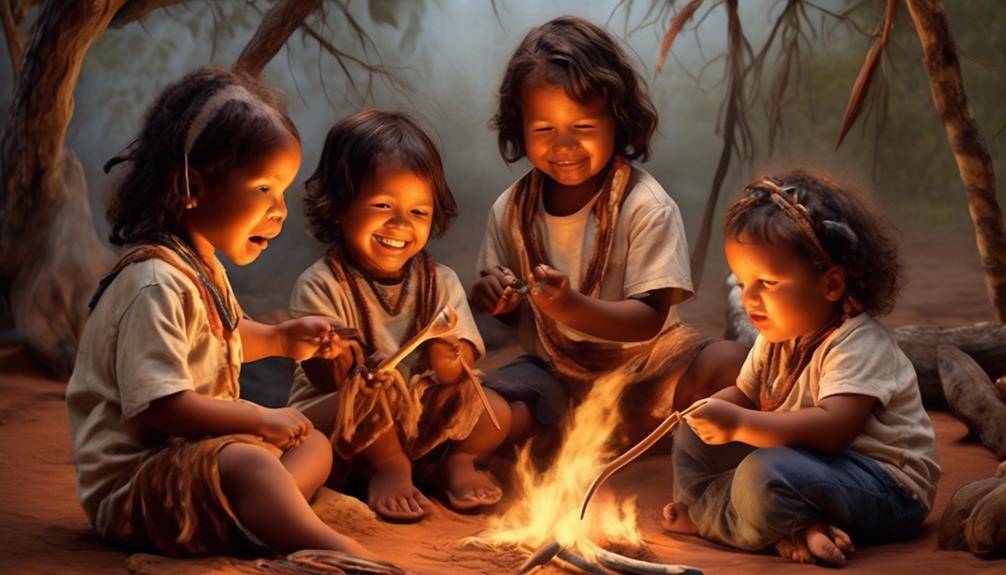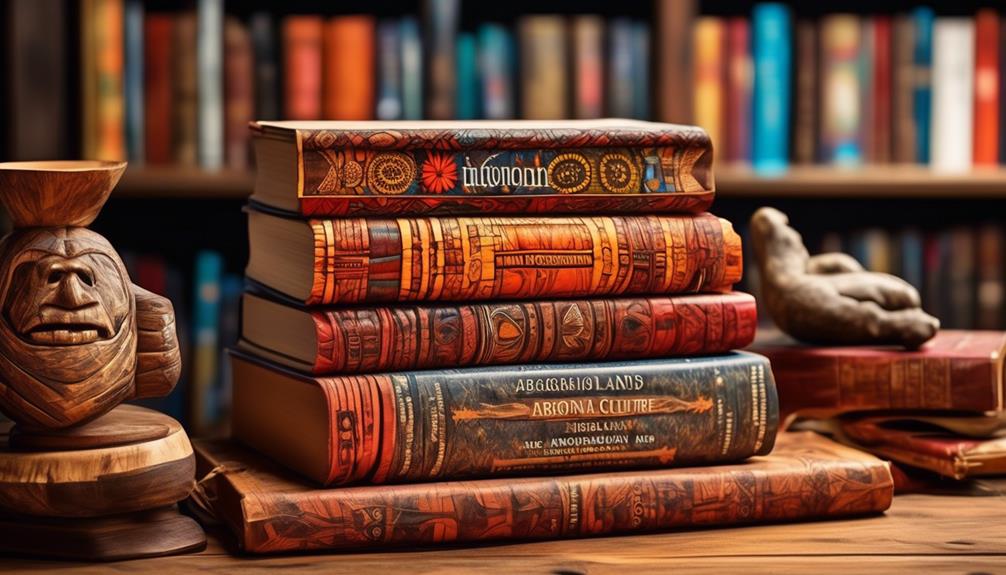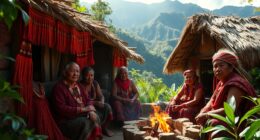When the British colonizers arrived in Australia for the first time, the Indigenous Australians reacted in manners often overlooked in historical records. The early exchanges between the two groups were complex and shaped by different cultural perspectives, leading to a relationship with lasting consequences.
The impact of the British settlers on the traditional lifestyle of the Aboriginal Australians was profound, leading to significant shifts in social structures and practices. However, this was only the beginning of a series of events that would shape the interactions between these two communities in ways that continue to resonate today.
Key Takeaways
- The arrival of British settlers brought significant changes to the way of life of Aboriginal Australians, resulting in cultural differences and difficulties in communication.
- The displacement from their lands disrupted the traditional hunter-gatherer society of Aboriginal Australians, leading to the breakdown of family units and the loss of spiritual connection.
- The disruption of their traditional lifestyle sparked resistance and conflict among Aboriginal Australians, who engaged in violent confrontations to defend their land and cultural heritage.
- The displacement and loss of land had enduring consequences, including the loss of economic independence, cultural identity, and ongoing struggles for land rights and the preservation of cultural heritage.
Initial Encounters With British Settlers
Upon the arrival of the British settlers, the Aboriginal Australians encountered a significant shift in their way of life, igniting a complex and often tumultuous relationship between the two groups. Cultural exchange between the Aboriginal Australians and the British settlers was marked by profound differences in language, customs, and traditions, leading to communication challenges that significantly impacted their initial encounters.
The British settlers arrived with their own cultural norms and expectations, which clashed with the established practices of the Aboriginal Australians. This led to misunderstandings and difficulties in effectively communicating and understanding each other's perspectives.
The cultural exchange was marred by a power imbalance, as the British settlers sought to assert their dominance and enforce their own systems upon the Aboriginal Australians. This imbalance further complicated communication and understanding. The clashes in cultural practices and the inability to effectively communicate exacerbated tensions and hindered the development of a harmonious relationship between the two groups.
Analyzing these initial encounters provides valuable insights into the complexities of cultural exchange and the profound impact of communication challenges on intergroup relations. Understanding these dynamics is crucial for serving others and promoting mutual understanding and respect in diverse communities.
Impact on Traditional Lifestyle
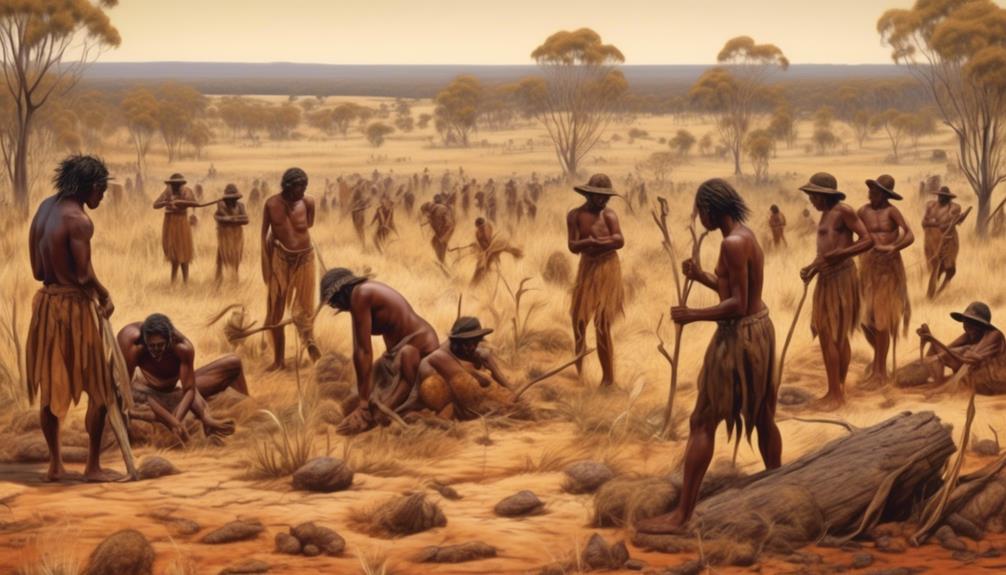
The arrival of the British settlers significantly disrupted the traditional lifestyle of the Aboriginal Australians, introducing profound changes and challenges that profoundly affected their way of life. The impact on their traditional lifestyle was immense, leading to cultural adaptation and societal changes.
| Traditional Lifestyle | Impact |
|---|---|
| Hunter-gatherer society | Displacement from lands |
| Spiritual connection | Disruption of ceremonies |
| Kinship structure | Breakdown of family units |
| Sustainable practices | Introduction of new diseases |
The traditional Aboriginal lifestyle, based on a hunter-gatherer society, was greatly impacted by the displacement from their lands, leading to a loss of cultural practices and traditional knowledge. The disruption of spiritual ceremonies and kinship structures further eroded the fabric of their society, causing a breakdown of family units and community cohesion. The introduction of new diseases also had a devastating effect on their population. The Aboriginal Australians faced immense challenges in adapting to these societal changes, requiring them to find ways to preserve their cultural identity while navigating the pressures of the new circumstances imposed upon them.
Resistance and Conflict
The disruption of traditional Aboriginal lifestyle by British settlers sparked a significant resistance and conflict as indigenous communities sought to defend their ancestral lands and cultural practices. This resistance often took the form of violent confrontations as Aboriginal Australians fiercely resisted the encroachment on their territories and the imposition of foreign customs and laws. The clash of cultures and the struggle for control of resources led to sustained periods of conflict, with both sides employing various tactics to assert dominance.
The violent resistance wasn't only a response to the loss of land and resources but also a defense of the Aboriginal way of life, which was deeply intertwined with the land itself. The clashes were fueled by a profound sense of injustice and a determination to preserve their cultural heritage in the face of colonial expansion. These conflicts had long-lasting effects on the social and political dynamics of the time, shaping the relationships between indigenous communities and the settlers.
Displacement and Loss of Land
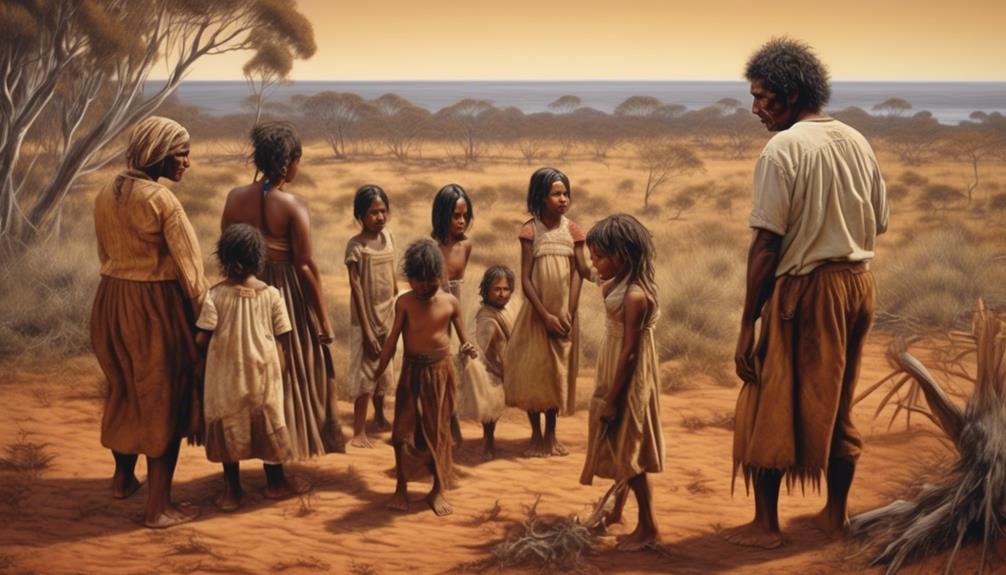
As British settlers expanded their presence in Australia, the displacement and loss of land experienced by Aboriginal Australians had profound and enduring consequences for their communities and cultural heritage. The effects of colonization were devastating, as traditional hunting and gathering grounds were seized, leading to the disruption of their way of life. The forced relocation from their ancestral lands resulted in the loss of spiritual connection to the land, impacting their cultural identity and sense of belonging. Additionally, the loss of land rights deprived Aboriginal communities of economic independence and self-sufficiency.
The long-term implications of this displacement are evident in the ongoing struggles for land rights and the preservation of cultural heritage. Despite efforts to address historical injustices through legal avenues and reconciliation processes, the intergenerational trauma stemming from the loss of land continues to affect Aboriginal communities today. The fight for land rights remains a central issue in the quest for social justice and empowerment for Aboriginal Australians.
Understanding the profound impact of displacement and loss of land is crucial in recognizing the ongoing challenges faced by Aboriginal communities and in working towards meaningful and sustainable solutions.
Long-term Cultural Ramifications
Significant cultural transformations occurred as a result of the enduring consequences of displacement and loss of land experienced by Aboriginal Australians due to British colonization in Australia.
The long-term cultural ramifications of this historical injustice have been profound, with effects that continue to reverberate through generations.
Cultural assimilation policies implemented by the British settlers aimed to erase Aboriginal traditions, languages, and ways of life, leading to a profound disruption of indigenous cultural practices.
This systematic dismantling of Aboriginal cultural identity has resulted in generational trauma, perpetuating a cycle of psychological and emotional distress within Aboriginal communities.
The loss of connection to ancestral lands and traditional knowledge has further exacerbated this trauma, impacting the well-being of Aboriginal Australians.
Furthermore, the erosion of cultural practices and values has hindered the transmission of indigenous knowledge and traditions to younger generations, contributing to a sense of cultural disconnection and loss.
The enduring effects of cultural assimilation and generational trauma continue to shape the lived experiences of Aboriginal Australians, highlighting the lasting impact of British colonization on indigenous cultural heritage.
Frequently Asked Questions
How Did the Aboriginal Australians Perceive the British Settlers in Terms of Their Cultural Practices and Beliefs?
In terms of perceptions and reactions, the Aboriginal Australians interacted with the British settlers through their cultural impact and belief systems. This interaction shaped their understanding of the newcomers and influenced their responses.
The clash of cultural practices and beliefs likely led to a range of emotions and behaviors from the Aboriginal Australians towards the British settlers.
These interactions provide valuable insights into the complexities of cross-cultural encounters and their lasting effects.
What Were the Specific Tactics Used by the Aboriginal Australians to Resist the Encroachment of British Settlers on Their Traditional Lands?
Tactical resistance was a crucial aspect of the Aboriginal Australians' response to the encroachment by British settlers. Their cultural perceptions informed their strategies, allowing for effective resistance.
Through allegory, one can perceive the rhythm and flow of their defiance, rooted in a deep connection to their traditional lands.
This resistance was a testament to their unwavering dedication to preserving their way of life.
How Did the Displacement and Loss of Land Affect the Spiritual and Emotional Well-Being of the Aboriginal Australians?
Losing land deeply impacted the spiritual resilience and emotional well-being of Aboriginal Australians. Their connection to the land was central to their cultural identity, and displacement caused profound trauma. The loss disrupted traditional ways of life, leading to a sense of disconnection and grief.
However, despite the immense challenges, many Aboriginal communities have shown remarkable strength in maintaining spiritual connections and rebuilding their cultural identities, demonstrating incredible resilience in the face of adversity.
What Long-Term Cultural Practices and Traditions Were Most Significantly Impacted by the Presence of British Settlers?
The impact of British settlers on Aboriginal traditions was profound. Cultural assimilation efforts resulted in loss of autonomy and disrupted longstanding practices. The settlers' presence significantly impacted traditional ceremonies, kinship systems, and land management.
Aboriginal resistance strategies, such as maintaining cultural practices in secret, were a response to these changes. These long-term impacts continue to shape the cultural landscape of Aboriginal communities today.
How Did the Introduction of British Laws and Governance Affect the Traditional Social Structure and Leadership Within Aboriginal Communities?
The introduction of British laws and governance significantly impacted the traditional social structure and leadership within Aboriginal communities. The imposition of foreign systems led to power struggles and the erosion of traditional leadership roles. This destabilized the established social order, causing unrest and tension.
The impact on leadership was profound, altering the dynamics of authority and decision-making. It's vital to understand these effects to appreciate the enduring ramifications on Aboriginal societies.
Conclusion
In conclusion, the impact of British settlers on Aboriginal Australians can be likened to a deep-rooted scar that continues to affect their cultural identity and traditional way of life. The initial encounters, resistance, displacement, and loss of land have left a lasting imprint on their community.
Like a tree stripped of its bark, the Aboriginal people have been stripped of their heritage, leaving a lasting and profound wound that continues to shape their experience to this day.
